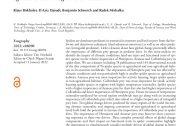Obsah
Spiders are dominant predators in terrestrial ecosystems and feed on prey from the herbivore and detritivore subsystem (dual subsystem omnivory) as well as on other predators (intraguild predation). Little is known about how global change potentially affects the importance of different prey groups in predator diets. In this meta-analysis we identify the impact of climatic conditions, land-use types and functional traits of spider species on the relative importance of Hemiptera, Araneae and Collembola prey in spider diets. We use a dataset including 78 publications with 149 observational records of the diet composition of 96 spider species in agricultural and non-agricultural habitats in 24 countries worldwide. The importance of Hemiptera prey was not affected by climatic conditions and was particularily high in smaller spider species in agricultural habitats. Araneae prey was most important for actively hunting, larger spider species in non-agricultural habitats. Collembola prey was most important for small, actively hunting spider species in regions with higher temperature seasonality. Spider species with a higher importance of Araneae prey for their diet also had higher importances of Collembola and lower importances of Hemiptera prey. Future increases of temperature seasonality predicted for several regions worldwide may go along with an increasing importance of Collembola prey which also related to a higher importance of intraguild prey here. Two global change drivers predicted for many regions of the world (increasing climatic seasonality and ongoing conversion of non-agricultural to agricultural land) both hold the potential to increase the importance of Collembola prey in spider diets. The importance of Hemiptera and Araneae prey may however show contrasting responses to these two drivers. These complex potential effects of global change components and their impact on functional traits in spider communities highlight the importance to simultaneously consider multiple drivers of global change to better understand future predator–prey interactions.



